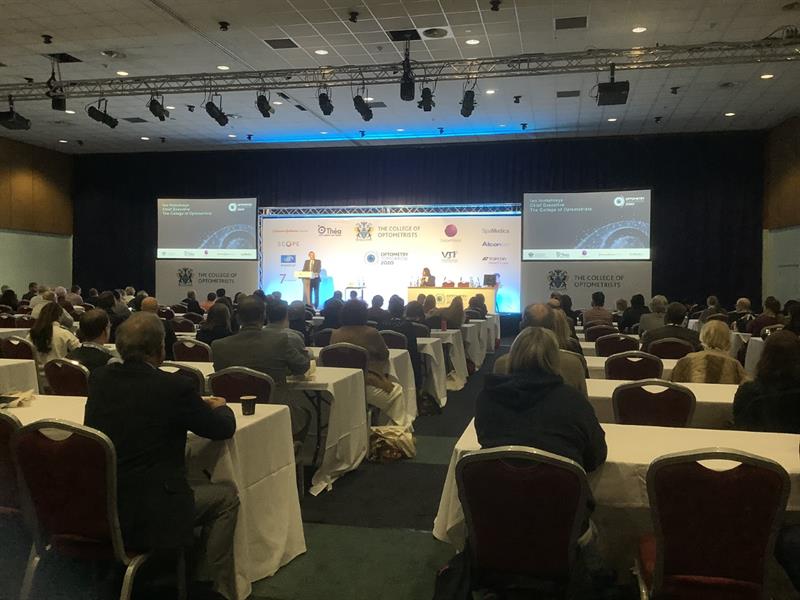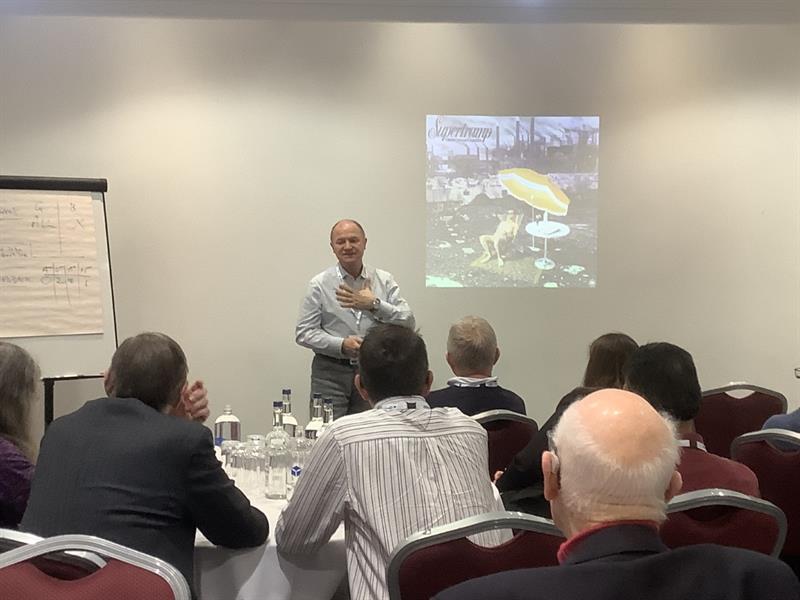
All delegates I spoke with while attending this year’s Optometry Tomorrow Conference, organised by the College of Optometrists, were impressed by the well-organised conference held at its new venue in the birthplace of the industrial revolution. Over 680 eye care professionals attended the conference in Telford (figure 1) and enjoyed a breadth of subjects covered by the various lectures, workshops and peer discussions taking place (figure 2).
 Figure 2: College of Optometrists Chief Executive Ian Humphreys welcomes over 680 delegates
Figure 2: College of Optometrists Chief Executive Ian Humphreys welcomes over 680 delegates
This was a fitting event for the 40th anniversary of the College of Optometrists and reflects well on how they have kept pace with the times as our profession has evolved. I highly recommend you consider attending next year’s event which will be held at the same excellent venue at a date soon to be announced.
Rather than bleat on about the quality of the sandwiches and how good everything was, I thought I might more usefully offer some key points I gained from the lectures and workshops I attended. In this feature I will cover the first day and next week will cover some highlights from the second day’s proceedings.
Glaucoma Update
Mr Leon Au, consultant ophthalmologist at the Manchester Royal Eye Hospital gave an update on the latest in glaucoma treatment (figure 3). Here are some key points he covered:
- Glaucoma treatment has varied little over the last decade, unlike most other areas of ophthalmology. The traditional approach has been first to use drops, then laser and then surgery. Recent developments mean that soon this is likely to change.
- Prostaglandin analogues were introduced way back in 1996 (when Xalatan was made available). The first major new drug group since then is soon to make an impact. ROCK inhibitors (as covered recently in this publication – see Optician 31.01.2020) show promise in their ability to lower intraocular pressure (IOP). They appear to be as effective as timolol, for example, and may have sufficient IOP lowering ability to make an impact upon low tension glaucoma treatment. They are likely to be used initially as an add-on therapy rather than first line.
- Drop use seems ‘archaic’. There are some new ways of delivering drugs to the anterior eye structures. Injectable pellets allow delayed release of a drug, but run the risk of accumulative debris after many years of use. Other routes being tried include rings placed in the fornices and also drug-releasing punctum plugs.
- The iDose is a small canister that releases drugs over a year directly into the trabecular meshwork.
- Selective laser trabeculoplasty (SLT) is commonly used as a first line treatment in the US and since the LiGHT study by Professor Gus Gazzard (see Optician 29.03.2019) is now being considered as a ‘game changer’ over here. However, the cost effectiveness argument in the LiGHT study ‘might be a bit off’.
- Surgical developments include MIGS, minimally invasive glaucoma surgery, and there are several options being looked at. These usually involve the insertion of IOP lowering devices and have the benefit of fewer drops, fewer complications than older surgical techniques, shorter surgery time, easier to perform (useful on a global level) and better and faster post-operative patient recovery. ‘No one should be on lots of drops with any adverse side effects these days,’ Au reinforced.
- The iStent is fired directly into Schlemm’s canal and allows aqueous drainage to bypass the trabecular meshwork. The Hydrus microstent is a bit larger and acts like a canula, helping aqueous to drain.
- The Xen is a 6mm long stent loaded into a needle and inserted via the sclera. It then softens and drains aqueous like a bleb. The 10 minute operation has had excellent IOP-lowering results.
- The InnFocus is a tiny tube which allows aqueous to drip out of the eye.
- The eyeWatch has a control mechanism which allows planned drainage of aqueous via a device with minimal endothelial damage as a result and managed IOP control.
 Figure 3: Leon Au and his glaucoma update
Figure 3: Leon Au and his glaucoma update
Referrals
Consultant ophthalmologist Teifi James (figure 4), he of the EyeBag fame, ran an excellent workshop looking at referral and describing ‘life at the receiving end.’ Key points:
- Unlike previous times where all referrals from optometrists went through the GP, most optometrists now have direct contact with secondary care. However, remember that if sending someone directly to accident and emergency, the chances are they will be seen by someone with minimal eye care training. ‘Don’t bother,’ was the advice.
- When professional bodies talk about the ‘greater patient need’ for the Hospital Eye Service, they are mistaken. Each year there are about eight million outpatient appointments in ophthalmology, about half of the number of eye tests each year in England. In fact, 20% of outpatient appointments are ophthalmology, but only about one in 30 hospital doctors are eye doctors. This is partly due to being ‘victims of our own success,’ with techniques such as phacoemulsification and injections of anti-VEGF coming to prominence.
- Discharges must exceed referrals, which is not the case at the moment and so clinics are full up.
- GP and direct referrals often lead to multiple referrals and so waste hospital appointments.
- A report has shown that only one in 10,000 patients lost to follow up suffered any harm.
- A recent audit of referrals in Halifax showed around two thirds to come from optometrists and one third from GPs. Of 81 urgent referrals, only 12 were confirmed to be urgent with 10 that may have been.
- Optometrists should avoid words such as ‘prompt’ or ‘soon’ as they are often treated by GPs as urgent. Also, 15% of ‘urgents’ are routine referrals that have sat at GP practices until being chased up and so are then referred on as urgent even though the original referral was routine.
 Figure 4: Teifi James explains why hospital appointments are at crisis levels
Figure 4: Teifi James explains why hospital appointments are at crisis levels
